You are reading the older HTML site
Positive Feedback
ISSUE
21
slim devices
Squeezebox2
as reviewed by Gary Beard
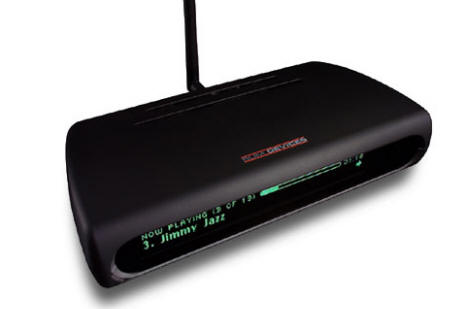
|
GARY L. BEARD'S SYSTEM
LOUDSPEAKERS
ELECTRONICS
SOURCES
CABLES
ACCESSORIES
|
The Squeezebox2 is a high-tech piece of computer hardware that plays computer music files and internet radio stations through its built-in Toslink or coax digital outputs (or its analog output), but there is more—the Squeezebox2 can stream musical ones and zeros from a remote location via its built-in 802.11g wireless capability, or hardwired via an onboard Ethernet connection. Slim Devices also makes an Ethernet-only version for the wireless-challenged, but for an additional fifty smackers you get both. This seems like a no-brainer to me. Small in size, the Squeezebox2 could easily be confused with a Sharper Image clock radio if weren't for its elegant fluorescent display ticker-taping the names of rock anthems and Bach sonatas across its front. Just so you know, it also has a setting that allows it to be used as an alarm clock!
The Squeezebox2 must be controlled from a computer running special software. This software, called Slim Server, is open source, which means that it is freely distributed, and that anyone who has the desire and knowledge can tweak, add to, and/or create updates and new applications. When installed on a Windows, Mac, or Linux-compatible computer, the Slim Server software runs as a web-based interface that allows the user to control all of the SB2's functions, from setup to music file management to internet radio capability. You can close the web browser window without stopping the server, in which case it will run "silently" in the background, playing music files stored on the computer. The software can also interface with Apple's iTunes, incorporating all of its existing music files and play-lists. The thing has so many options and parameters that an entire book could be written about it, but instead of continuing to butcher the digital-operative lingo, I will describe my experience with this third-generation Slim Devices music player.
I have no experience with Slim Devices' inaugural product, the SLIMP3 Networked Music Player, but I do own the first-generation Squeezebox. Because I was satisfied with its performance as a whole-house music server, I gave it a trial run in my main two-channel system. While not awed by its performance, I was sufficiently intrigued that when the Squeezebox2—with its faster, wireless connection and supposedly more robust audio performance—was announced, I immediately put my name on the list for a review unit. My previous experience had prepared me for wading through the treacherous waters of wireless computing. Using the 802.11g wireless standard, the Squeezebox2 is much faster than the original. Gone are the occasional dropouts and slow access times that compromised the functionality of the first Squeezebox. The Squeezebox2 is a terrific upgrade for the same money. It is faster, has nearly zero dropouts, and with its new Burr-Brown DAC and low-jitter clock, the sound approaches a level that even the most jaded audiophiles can enjoy.
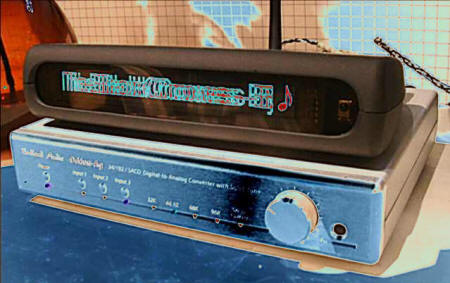
The big difference between the Squeezebox2 and every other audio component in my home is its relative complexity. Does that mean that it is difficult to use? Yes and no. Though it certainly helps to be computer-literate, anyone who has downloaded and installed software from the Internet will find the Squeezebox2 easy to set up. The earliest versions of the software had a penchant for crashing emails and documents as you tried to save them, but this has been fixed, and I have had very few problems. In addition to all of the computer crazies that have pushed the evolution of Slim Server along so rapidly, there are many folks developing software add-ons and plug-in programs to use with the SB2. The fact that the Squeezebox2 should continually improve for some time to come is one of its most important virtues. At a time when technical obsolescence can occur virtually overnight, it is comforting to know that someone will always be trying to make the SB2 work better, even after it is no longer the new toy in town.
Now that you have downloaded the Slim Server freeware and have it running, you are ready to rock, right? Perhaps so, if you are using an Ethernet connection or already have a wireless system in place. If neither is the case, I'm afraid you'll need to set up either a wired or a wireless network. Both are simple tasks—for a computer geek. I went wireless, as I wanted to be able to move my system to different rooms without having to run a CAT5 cable to every corner of my little house on the prairie. I have a wireless Access Point that is connected via Ethernet to my hardwired router. I was lucky enough to have a spare CAT5 cable from my router to a centrally located closet that was no longer being used for computer duties. This location gives me great coverage, and I get a wireless signal strength that averages in the 80 percent range. Setting up the Access Point was not entirely painless–it took a week or two to get the gremlins out—but once accomplished, it worked without a hitch.
Though the Squeezebox2 itself must also be set up, this is MUCH simpler than it was with the original Squeezebox. (I don't really know why, but without a doubt it is. I only know enough to be dangerous—I read the directions and when I can't make it work, I get my kid to fix it.) The good news is that the new unit will usually connect automatically, but it might not, in which case a bit of sleuthing is in order. It certainly helps to have a modicum of knowledge about IP addresses and DNS servers. You don't have to be Bill Gates, but a computer novice will undoubtedly struggle if things don't go smoothly. It might be smart to have the computer cavalry on standby, they may need to ride in and save the day. It should also be noted that funny things happen when the power goes off, so after a storm knocks out the grid, your Squeezebox may have some (hopefully) momentary brain dysfunction. Every system will be different, so there is no magic bullet except rolled sleeves and good fortune. If I've made setting up the SB2 sound like a task of Herculean proportions, don't fret, because truthfully, almost anyone can do it.
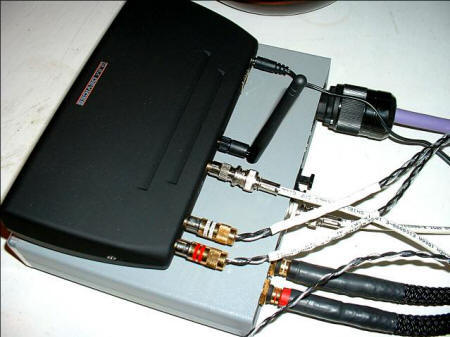
Once the system is up and running, it will need some tunes to play. You could load crappy MP3 files onto your computer's hard drive, but hey, we're power users here in audiophile land! I purchased a Maxtor 300-gig external USB hard drive, then spent days and days ripping (transferring via a computer program) all my CDs with Apple's iTunes program, converting from Redbook format into Apple Lossless files to save space while leaving quality intact. I currently have almost 6000 songs by over 440 artists, with room for another 5 or 6000 before I have to run out and buy another drive. And yes, any prudent person would have a second drive set as a backup in case a crash takes place. It did take an excruciatingly long time to rip all those CDs, and I would hate to have to do it again. I guess I'd better become a prudent man. and soon!
While the Slim Server is quite adept at running the SB2, it is a bit rough around the edges. Since you need a separate program to transfer your digital discs to the computer anyway, and being a simple kind of guy, I settled on iTunes to handle my music management duties. Many computer music gurus swear by Exact Audio Copy (EAC) to convert CDs. If they want to save computer space, they convert those .WAV files to the lossless compression format of FLAC. While this may yield superior file transfers, to the best of my knowledge, FLAC files will not work with iTunes. Why, then, do I use it? Apple's Lossless format sounds very good, and that makes it simple. This is my version of simplicity:
1. Download iTunes.
2. Set iTunes to convert CDs to Apple Lossless format with error checking enabled.
3. Rip hundreds and hundreds of discs.
4. Make up play-lists to your heart's desire.
5. Enter the path to the iTunes folder in the Slim Server software.
6. Play back play-lists by choosing them either in the Slim Server software at the computer, or by using the remote control to scroll through them in the Squeezebox2 display.
That is the abridged version of setting up the Squeezebox2. If you want more information, you'll need to visit the Slim Devices' website (www.slimdevices.com), where you can download the software, check out the FAQs, and browse the informative user's forum. It will also be worthwhile to find a good computer webzine review, which will surely touch upon many more setup issues and options.
The SB2 clearly outperforms the original Squeezebox by a wide margin and in every category, including sound. Both units offer a remote control that operates every necessary function. Its operation is intuitive. After scrolling through the functions a few times, even the most tech-adverse should be able to access music, change volume, play internet radio, and execute the basic commands: play, pause, next track, and stop. There is a dizzying array of options, mostly having to do with setup of the unit. The only ones I really use are displaying the setup menu, setting the fade in/fade out/crossfade options, and choosing where to locate my default music storage folder. When setting the display, there are many different visualizers to choose from, including analog VU meters and scrolling newscasts, but I chose to see the title, artist, album, and year of the music being played. Again, I have only scratched the surface of what is available. Anything beyond the best sound with the fewest glitches is computer gee-whiz territory and not my bag.
One very cool thing about the little black plastic Squeezebox2 is its ability to stream SHOUTcast, Radioio, and Live365 Internet radio stations. If you've never used Internet radio, it is a great way to listen to music and stimulating discussions from around the globe. One night I lucked onto an Irish radio station playing drunken jigs and reels streamed live from a Dublin pub. Internet radio makes the Squeezebox2 worth the price all by itself, but what could be even better is a feature so new that I have yet to really use it—the SqueezeNetwork, which has just been introduced, promises to allow the SB2 to connect to services like streaming radio without running the Slim Server (hence the computer). Righteous, dude!
If small and simple is your ideal, buy a Squeezebox2, connect it directly to a power amp or powered speakers, and control the volume via the Squeezebox2's 40-step digital volume attenuator. You'll have a fine, simple audio system. To hear the SB2 at its best, selecting two options in the Slim Server "Player Settings" window is very important. Disabling the digital volume control by selecting "Digital output level is fixed" and "No Limit" on the bitrate option allows the Squeezebox2 to bypass the digital volume control and play files at their highest recorded bit rate, with the following caveat—at present, file playback is limited to 48 or 44.1khz sample rates or below in the PCM audio format of 16 or 24 bits per sample. As a computer-based digital playback system, one of the most important features of the Squeezebox2 is its ability to play a plethora of popular computer music formats, including .WAV, Apple Lossless, Windows Media, FLAC, Ogg Vorbis, and of course, the dreaded MP3. Aside from great sound, the ability to play lossless formats is (to me) the SB2's most important feature. Without this capability, my hard drive space would be nearing extinction, yet I would never commit the sacrilege of converting perfectly good CDs to MP3 for playback through a Fi-X tube amp!
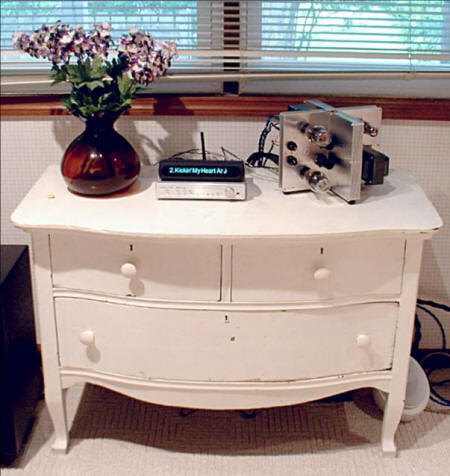
As I have gained experience as an audio writer, it has become increasingly difficult for me to describe the sound of components. I have become keenly aware that great audio reproduction can only be the result of a carefully assembled system. This is especially true of the Squeezebox2. Its built-in Burr-Brown DAC is lightyears beyond its forerunner in sound quality. While the SB2's internal DAC really does sound very good—stout bass, extended treble, clean mids, and excellent resolution—it seems a bit sloppy and ragged compared to its S/PIDF coax output connected to my Birdland Odeon-AG DAC. In my opinion, it is the SB2s new lower-jitter digital output that allows it to become an integral part of a high-performance audio system.
While I am not going to give you the usual blow-by-blow audiophile commentary, there are some important things to note about the Squeezebox2's performance with an outboard DAC. Using its coax digital output, the SB2 is very silent. A lot of audiophiles dislike the word "neutral," since no one can really define what it means. Still, the Squeezebox, used as a transport, does not seem to add any sound of it own. How do I know that? For a short but sweet time, I had an Audio Note DAC connected to the SB2. The AN's sound was amazingly forthright and highly transparent, with deep bass, extended treble, and wonderfully rhythmic drive. Alas, the unit eventually traveled eight hours north with its owner. The Odeon-AG sounds wholly different than the AN. Its resolution at low levels is stellar, as is its imaging. It also has beautiful tone, and the sound just pours out in a pure, musical stream. Nevertheless, it has less drive than the AN and lacks the AN's deep bass capability. Both DACs sound wonderful, and both sound distinctly different. With both, I can hear the Fi-Xi doing its brilliant 2A3 tube thang, and can clearly hear the differences in speakers, so without further ado, I pronounce the Squeezebox2's digital output to be neutral.
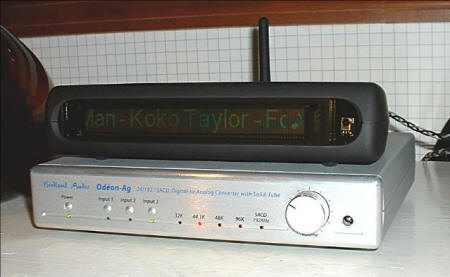
Does this mean that I think the Squeezebox2 is the best digital transport around? Hell no! But I do feel that it compares nicely with many of the disc slingers I've tried. Paired with the Birdland DAC, it is not in the same league as the Lector Alphatop, which is the finest I have heard. The combo sounds different than the high-energy preciseness of the Cary 303-200, but very much like the laid back Metronome. It should be noted that I no longer strive for the ultimate stars of audio space. My gear is good, but simple and relatively inexpensive. My focus is on synergy and great sound for the money. The Squeezebox2 lacks the effortless air and space of the best digital gear I've heard, so it might not be the best transport for a megabuck, pick-out-the-rosin-on-the-bow system, but you know what? It kicks ass in the realm of convenience, and sounds really, really good doing so.
The SB2 is making some waves in the DIY and high-performance modding community, and there are some talented people who are engineering modifications to take this unit to the next level of performance. One modder in particular, Vinnie Rossi of Red Wine Audio, has taken the SB2 off the power grid. Vinnie tells me that his extensive internal modifications and SLA battery power improve the SB2's sound to the point that an outboard DAC is no longer needed, and he uses the digital volume control!
Something new and perhaps better is always right around the techno-corner, but by waiting for the perfect solution we sometimes miss an opportunity to try a truly innovative product, even if it is not perfect. There are other devices on the market that wirelessly stream music, and they may be just as terrific as the SB2. I bought my original Squeezebox for its Apple Lossless capabilities, and I will be buying the Squeezebox2 for its excellent audio performance. I now use the SB2 daily for critical listening, and I am blissfully in the land of fingertip music. It is an addictive and marvelous way to listen. It is like having my own high-quality radio station, without the brainless, time-wasting commercials. I cannot say that the Squeezebox2 is for Joe Everyconsumer, as it has all the quirky earmarks of computer-based technology, yet the SB2 is so astoundingly convenient, and sounds so good, that it can no longer be ignored. If you can deal with the vagaries of computers, are willing to commit a few bucks to set up a wireless network (or even just a Ethernet cable slung through the house), and don't mind spending a few days, or weeks, converting CDs into computer files, you can have a wonderful taste of audio's future right now, for a mere 250 dollars. Gary Beard
Squeezbox2
Retail: $199
Slim Devices
web address:
www.slimdevices.com
